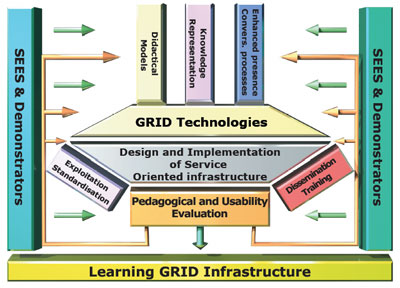|
|||
The European Learning Grid Infrastructure Integrated Projectby Pierluigi Ritrovato and Matteo Gaeta A semantic Grid for human learning is the vision behind the European ELeGI Integrated Project for the implementation of future learning scenarios based on ubiquitous, collaborative, experiential-based and contextualized learning through the design, implementation and validation of the Learning Grid. In recent years, teaching and learning practices have been mainly based on the information transfer paradigm. This focuses on content, and on the teacher as the key authoritative figure who provides information. Teachers’ efforts have generally been devoted to finding the best ways of presenting content in order to transmit information to learners. Unfortunately the current generation of ‘e-Learning solutions’ has adopted the rather narrow pedagogic paradigm of ‘information transfer’. This occurred simply because it is an easy way to use the Web’s basic facilities. Failures, such as massive drop-out rates, are usually explained by a lack of staff awareness in the use of the Web, rather than critical reflection on the limits of this approach. So, the question remains – how do we provide better access while maintaining or improving quality of learning through the use of ICT? The aim of ELeGI (European Learning Grid Infrastructure), an EU-funded Integrated Project (23 partners from nine EU countries), is to promote effective human learning by demonstrating and supporting a learning paradigm shift from the current idea of information transfer to one that focuses on the learner and on the construction of knowledge using experiential and collaborative learning approaches in a contextualized, personalised and ubiquitous way. In our vision, the learner has an active and central role in the learning process. Learning activities are aimed at aiding the construction of knowledge and skills in the learner, rather than the memorisation of information. In keeping the learner at the centre of the learning process, personalisation (exploiting the existing learner’s capability and skills) and individualisation (creating and adapting learning paths according to learner’s preferences) become relevant aspects to be supported by technologies through the creation of the right context. The Learning Grid An open distributed service model is based on a concept of service (which in our context differs from a product) as a kind of predefined combination of processes yielding some result (the goal of the service) from distributed, heterogeneous, asynchronously communicating and available resources. The next generation of Grid solutions will increasingly adopt the service-oriented model for exploiting commodity technologies. The goal of this model is to enable and facilitate the transformation of information into knowledge, by humans as well as – progressively – by software agents, providing the electronic underpinning for a global society in business, government, research, science, education and entertainment (semantic aspects). We refer to these efforts as the ‘semantic grid’. According to this technology scenario, the research at ELeGI should address the creation of a semantic grid for human learning: the Learning Grid. The Learning Grid is a semantically enriched grid that, bringing together the features of Grid and semantic technology, represents our solution for the creation of future learning scenarios. It is based on the OGSA model, so it inherits all the features of that architecture. As an example of the potential offered by the Learning Grid, we provide a short description of how it should support all the phases of an IMS-Learning Design specification. Authoring tools for the production of learning scenarios can rely on knowledge-based decision-making systems to suggest pedagogical models and/or activities to suit the situation. This is done using knowledge of both the context and the people involved in the scenario (eg starting skills, personal profiles etc). Furthermore, experts can use the collaborative features of the Grid to cooperate in modelling the scenario. In this way, the Learning Grid supports the analysis, modelling and development phases of Learning Design documents. In the delivery phase, the Learning Design document should be understood and its content executed.
The Learning Grid uses its knowledge (represented through OWL-S ontology) to cross-reference learner preferences and the pedagogical model with the tools, resources and activities available on the Grid. The Learning Grid makes available a learning scenario virtualized as a 'Human Learning Service', with all its 'implicit knowledge' (pedagogical model, learning goals, resources and activities involved, etc…) as a building block for the creation of more complex and interactive learning experiences composed of different scenarios and contexts. The Methodology and Approach Links: Please contact: |
|||



